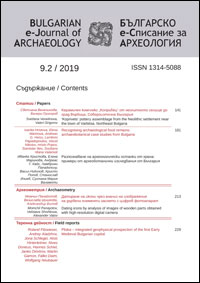Керамичен комплекс „Копривец“ от неолитното селище до град Върбица, Североизточна България
‘Koprivets’ pottery assemblage from the Neolithic settlement near the town of Varbitsa, Northeast Bulgaria
Author(s): Svetlana Venelinova, Valeri GrigorovSubject(s): History, Archaeology
Published by: Асоциация на българските археолози
Keywords: pottery assemblage ‘Koprivets’; Varbitsa; Early Neolithic;
Summary/Abstract: The article presents the pottery from the early phase of the Neolithic settlement near the town of Varbitsa, which has the characteristics of the Koprivets cultural group. The pottery assemblage originates from sondage 1, stratigraphic layers XI–XV. The information of 1,113 fragments has been statistically analyzed. There are three technological groups: brown (68.4%); beige (21.4%) and grey-black (10.2%). A distinctive feature of the assemblage are the vessels with red engobe (9.8%). Among the indicative features of the pottery from Varbitsa are 14 red-engobe fragments with traces of white painted decoration. Decoration was found on 9.34% of the fragments. The pottery shapes are classified into six functional types: dishes (I), pots (II), bowls (III), cups (IV), tulip-like vessels (V) and storage vessels (VI). The assemblage was analysed by stratigraphic layers. In terms of formative and technological features, the pottery from the early phase of the Neolithic settlement near the town of Varbitsa has the basic characteristics of the Koprivets cultural group, similar to the late-phase assemblages of the so-called ‘painted period’. In terms of shape, the vessels from Varbitsa find numerous analogies with the pottery from the sites of Orlovets and Belyakovets–Plochite in central northern Bulgaria, and Kapitan Dimitrievo in Thrace.
Journal: Българско е-Списание за Археология
- Issue Year: 9/2019
- Issue No: 2
- Page Range: 141-180
- Page Count: 40
- Language: Bulgarian

